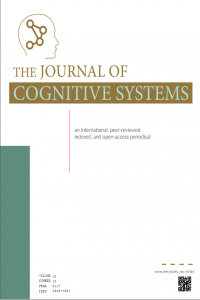Research Article
Year 2017,
Volume: 2 Issue: 2, 44 - 46, 01.12.2017
Abstract
References
- [1] Brazier, M. A. B., A History of the Electrical Activity of the Brain; The First Half-Century, Macmillan, New York, 1961.
- [2] Massimo, A., ‘In Memoriam Pierre Gloor (1923–2003): an appreciation’, Epilepsia, 45(7), July 2004, 882.
- [3] Grass, A. M., and Gibbs, F. A., ‘A Fourier transform of the electroencephalogram’, J. Neurophysiol., 1, 1938, 521–526.
- [4] Shipton, H. W., ‘EEG analysis: a history and prospectus’, Annual Rev., Univ. of Iowa, USA, 1975, 1–15.
- [5] Busemeyer, J. R., & Bruza, P. D. (2012). Quantum models of cognition and decision. Cambridge: Cambridge University Press.
- [6] Haven, E., & Khrennikov, A. Y. (2013). Quantum social science. Cambridge: Cambridge University Press.
- [7] Bell, J. S. (1966). On the problem of hidden variables in quantum theory. Reviews of Modern Physics, 38, 447-452.
- [8] Leggett, A. J., & Garg, A. (1985). Quantum mechanics versus macroscopic realism: Is the flux there when nobody looks? Physical Review Letters, 54, 857-860.
- [9] Ashwal, S., and Rust, R., ‘Child neurology in the 20th century’, Pedia. Res., 53, 2003, 345–361.
- [10] Niedermeyer, E., ‘The normal EEG of the waking adult’, Chapter 10, in Electroencephalography, Basic Principles, Clinical Applications, and Related Fields, Eds E. Niedermeyer and F. Lopes da Silva, 4th edn, Lippincott, Williams and Wilkins, Philadelphia, Pennsylvania, 1999, 174–188.
- [11] EEG Signal Processing S. Sanei and J. Chambers 2007 John Wiley & Sons, Ltd.
- [12] Atmanspacher, H., Römer, H., & Walach, H. (2002). Weak quantum theory: Complementarity and entanglement in physics and beyond. Foundations of Physics, 32, 379_406.
- [13] Necker, L. A. (1832). Observations on some remarkable phenomenon which occurs in viewing a figure of a crystal or geometrical solid. The London and EdinburghPhilosophy Magazine and Journal of Science, 3, 329_337.
- [14] Atmanspacher, H., Filk, T., & Römer, H. (2004). Quantum Zeno features of bistable perception. Biological Cybernetics, 90, 33_40.
- [15] Atmanspacher, H., Filk, T., & Römer, H. (2008).Complementarity in bistable perception. In H. Atmanspacher, & H. Primas (Eds.), Recasting reality _ Wolfgang Pauli's philosophical ideas in contemporary science (pp. 135_150). Berlin: Springer.
- [16] Atmanspacher, Filk, T (2010). proposed test of temporal nonlocality in bistable perception. Journal of Mathematical Psychology 54, 314_321.
- [17] Misra, B.,&Sudarshan, E. C. G. (1977). The Zeno's paradox in quantum theory. Journal of Mathematical Physics, 18, 756_763.
- [18] Piantoni G. et. Al., Alpha Power Predicts Persistence of Bistable Perception, Sci. rep. 7, 5208.
Year 2017,
Volume: 2 Issue: 2, 44 - 46, 01.12.2017
Abstract
Understanding the mechanisms of human decision making
is of significant importance to the cognitive science. Today’s motivation on
artificial intelligence and machine learning has been focused on more humanoid
machines. Classical machine learning algorithms are based on classical logic
and probability. However, empirical evidence shows that human decision behavior
reveals some non-classical aspects such as context effects, order effects or
ambiguity aversion. Electroencephalography (EEG) is a well-known way to obtain
and interpret the brain signals for diverse goals. This study presents standard
EEG methods to obtain the data, then some methods will be briefly surveyed
analyzing non-classical effects by using EEG data.
References
- [1] Brazier, M. A. B., A History of the Electrical Activity of the Brain; The First Half-Century, Macmillan, New York, 1961.
- [2] Massimo, A., ‘In Memoriam Pierre Gloor (1923–2003): an appreciation’, Epilepsia, 45(7), July 2004, 882.
- [3] Grass, A. M., and Gibbs, F. A., ‘A Fourier transform of the electroencephalogram’, J. Neurophysiol., 1, 1938, 521–526.
- [4] Shipton, H. W., ‘EEG analysis: a history and prospectus’, Annual Rev., Univ. of Iowa, USA, 1975, 1–15.
- [5] Busemeyer, J. R., & Bruza, P. D. (2012). Quantum models of cognition and decision. Cambridge: Cambridge University Press.
- [6] Haven, E., & Khrennikov, A. Y. (2013). Quantum social science. Cambridge: Cambridge University Press.
- [7] Bell, J. S. (1966). On the problem of hidden variables in quantum theory. Reviews of Modern Physics, 38, 447-452.
- [8] Leggett, A. J., & Garg, A. (1985). Quantum mechanics versus macroscopic realism: Is the flux there when nobody looks? Physical Review Letters, 54, 857-860.
- [9] Ashwal, S., and Rust, R., ‘Child neurology in the 20th century’, Pedia. Res., 53, 2003, 345–361.
- [10] Niedermeyer, E., ‘The normal EEG of the waking adult’, Chapter 10, in Electroencephalography, Basic Principles, Clinical Applications, and Related Fields, Eds E. Niedermeyer and F. Lopes da Silva, 4th edn, Lippincott, Williams and Wilkins, Philadelphia, Pennsylvania, 1999, 174–188.
- [11] EEG Signal Processing S. Sanei and J. Chambers 2007 John Wiley & Sons, Ltd.
- [12] Atmanspacher, H., Römer, H., & Walach, H. (2002). Weak quantum theory: Complementarity and entanglement in physics and beyond. Foundations of Physics, 32, 379_406.
- [13] Necker, L. A. (1832). Observations on some remarkable phenomenon which occurs in viewing a figure of a crystal or geometrical solid. The London and EdinburghPhilosophy Magazine and Journal of Science, 3, 329_337.
- [14] Atmanspacher, H., Filk, T., & Römer, H. (2004). Quantum Zeno features of bistable perception. Biological Cybernetics, 90, 33_40.
- [15] Atmanspacher, H., Filk, T., & Römer, H. (2008).Complementarity in bistable perception. In H. Atmanspacher, & H. Primas (Eds.), Recasting reality _ Wolfgang Pauli's philosophical ideas in contemporary science (pp. 135_150). Berlin: Springer.
- [16] Atmanspacher, Filk, T (2010). proposed test of temporal nonlocality in bistable perception. Journal of Mathematical Psychology 54, 314_321.
- [17] Misra, B.,&Sudarshan, E. C. G. (1977). The Zeno's paradox in quantum theory. Journal of Mathematical Physics, 18, 756_763.
- [18] Piantoni G. et. Al., Alpha Power Predicts Persistence of Bistable Perception, Sci. rep. 7, 5208.
There are 18 citations in total.
Details
| Primary Language | English |
|---|---|
| Journal Section | Articles |
| Authors | |
| Publication Date | December 1, 2017 |
| Published in Issue | Year 2017 Volume: 2 Issue: 2 |


